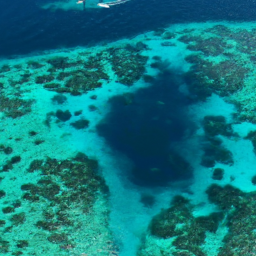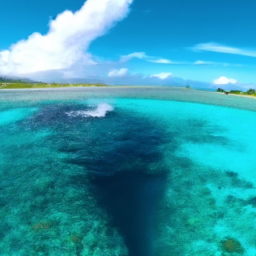Captivating Beauty: Discover the Enchanting Sea of Stars in the Maldives
Introduction
The Maldives, a tropical paradise in the Indian Ocean, is renowned for its breathtaking natural beauty. Among its many wonders, one phenomenon stands out: the Sea of Stars. This awe-inspiring spectacle occurs at night when bioluminescent phytoplankton illuminate the water, creating a mesmerizing display of glowing blue lights. These images of the Maldives’ Sea of Stars captivate and enchant viewers, showcasing the magical allure of our planet’s natural wonders.
The Mesmerizing Phenomenon of Bioluminescent Plankton in the Maldives
The Maldives, a tropical paradise in the Indian Ocean, is renowned for its pristine beaches, crystal-clear waters, and vibrant marine life. However, there is one phenomenon that sets this archipelago apart from other destinations – the mesmerizing sea of stars. This awe-inspiring spectacle is created by bioluminescent plankton, tiny organisms that emit a radiant blue glow when disturbed.
Imagine walking along the shoreline at night, with the moon casting a soft glow on the water. Suddenly, as you take a step, the sand beneath your feet lights up, creating a trail of shimmering blue light. This magical display is the result of millions of bioluminescent plankton reacting to movement. It is a sight that leaves visitors spellbound and captivated by the beauty of nature.
Bioluminescence is a natural phenomenon that occurs when certain organisms, such as plankton, produce and emit light. In the case of the Maldives, the bioluminescent plankton responsible for the sea of stars is known as dinoflagellates. These single-celled organisms possess a unique ability to produce light through a chemical reaction called bioluminescence.
The mesmerizing glow of the bioluminescent plankton is a defense mechanism. When disturbed, the plankton release a burst of light, which serves to startle and confuse potential predators. This stunning display not only protects the plankton but also creates a breathtaking spectacle for those lucky enough to witness it.
The best time to experience the sea of stars in the Maldives is during the dark nights of the new moon. With minimal light pollution, the bioluminescent plankton can truly shine and create a surreal atmosphere. Visitors often embark on night-time boat trips or take a dip in the water to witness this natural wonder up close.
As you glide through the water, every movement creates a trail of glowing blue light. The waves sparkle and shimmer, resembling a starry night sky reflected on the surface of the ocean. It is a truly magical experience, as if you are swimming among the stars themselves.
The sea of stars is not limited to a specific location in the Maldives. However, some islands and resorts are known for offering the best opportunities to witness this phenomenon. Vaadhoo Island, located in the Raa Atoll, is particularly famous for its bioluminescent beach. Here, visitors can stroll along the shoreline, leaving a trail of glowing footprints behind them.
Another popular spot is Mudhdhoo Island, where the sea of stars can be observed from the comfort of luxurious resorts. Imagine lounging on a private deck, sipping a cocktail, and watching as the water beneath you comes alive with a radiant blue glow. It is an experience that will leave you in awe of the wonders of nature.
In conclusion, the sea of stars in the Maldives is a mesmerizing phenomenon created by bioluminescent plankton. This natural spectacle, with its shimmering blue glow, is a sight that leaves visitors in awe of the beauty of the world we live in. Whether you choose to witness it from the beach or from the deck of a resort, the sea of stars is an experience that will stay with you long after you leave this tropical paradise.
Capturing the Enchanting Sea of Stars: Photography Tips for the Maldives

The Maldives, a tropical paradise in the Indian Ocean, is known for its pristine white sandy beaches, crystal-clear turquoise waters, and vibrant marine life. But there is one natural phenomenon that sets this archipelago apart from any other destination in the world – the Sea of Stars. This awe-inspiring spectacle is a must-see for any traveler with a passion for photography.
The Sea of Stars, also known as bioluminescence, is a natural phenomenon caused by tiny marine organisms called phytoplankton. These organisms emit a blue glow when they are disturbed by movement in the water. When the conditions are just right, the entire shoreline of the Maldives lights up like a starry night sky, creating a mesmerizing and enchanting experience.
Capturing the Sea of Stars on camera can be a challenging task, but with the right techniques and equipment, you can create stunning images that will leave your friends and family in awe. Here are some photography tips to help you capture the enchanting Sea of Stars in the Maldives.
First and foremost, it is important to choose the right time and location. The Sea of Stars is most visible during the months of June to October, when the water is warm and the phytoplankton are most active. Some of the best locations to witness this phenomenon include Vaadhoo Island, Mudhdhoo Island, and Raa Atoll. These areas have less light pollution, allowing for clearer and more vibrant images.
When it comes to equipment, a camera with manual settings is essential. This will allow you to have full control over your exposure, focus, and shutter speed. A wide-angle lens is also recommended, as it will allow you to capture more of the scene and create a sense of depth in your images.
To capture the bioluminescence, it is important to use a long exposure. This means keeping your shutter open for a longer period of time, usually between 10 to 30 seconds. This will allow the camera to capture the faint glow of the phytoplankton and create a dreamy effect in your images. To avoid camera shake, it is recommended to use a tripod or stabilize your camera on a solid surface.
In terms of settings, start with a low ISO, around 100 to 200, to minimize noise in your images. Set your aperture to a small f-stop, such as f/8 or f/11, to ensure that everything in your frame is in focus. Experiment with different shutter speeds to find the perfect balance between capturing the glow of the phytoplankton and maintaining the natural colors of the surroundings.
Composition is key when photographing the Sea of Stars. Look for interesting foreground elements, such as rocks or trees, to add depth and perspective to your images. Experiment with different angles and perspectives to create unique and captivating compositions. Don’t be afraid to get low to the ground or try different vantage points to capture the beauty of this natural phenomenon.
Lastly, post-processing can enhance the beauty of your images. Adjust the exposure, contrast, and saturation to bring out the colors and details in your photos. Be careful not to overdo it, as you want to maintain the natural look and feel of the Sea of Stars.
Capturing the enchanting Sea of Stars in the Maldives is a once-in-a-lifetime experience. With the right techniques and equipment, you can create stunning images that will transport you back to this magical place. So pack your camera gear, head to the Maldives, and get ready to capture the beauty of the Sea of Stars.
Exploring the Mystical Sea of Stars: A Guide to Witnessing this Natural Wonder in the Maldives
The Maldives, a tropical paradise in the Indian Ocean, is known for its pristine beaches, crystal-clear waters, and vibrant marine life. But there is one natural wonder that sets it apart from other destinations – the Sea of Stars. This awe-inspiring phenomenon, also known as bioluminescence, turns the ocean into a magical spectacle of glowing blue lights. If you’re planning a trip to the Maldives and want to witness this mystical phenomenon, here is a guide to help you make the most of your experience.
The Sea of Stars is caused by tiny marine organisms called bioluminescent phytoplankton. These microorganisms emit light when they are disturbed, creating a mesmerizing display of glowing blue lights in the water. The phenomenon is most commonly observed in Vaadhoo Island, located in the Raa Atoll of the Maldives. However, it can also be seen in other parts of the country, such as Mudhdhoo Island and Hanifaru Bay.
To witness the Sea of Stars, it is best to visit the Maldives during the dry season, which runs from November to April. During this time, the weather is generally sunny, and the water is calm, providing ideal conditions for observing the bioluminescence. It is also recommended to visit on a moonless night, as the darkness enhances the visibility of the glowing lights.
When planning your trip, it is important to choose accommodation that is close to the areas where the Sea of Stars can be observed. Many resorts in the Maldives offer night excursions to witness this natural wonder. These excursions typically involve a boat ride to the bioluminescent areas, where you can swim or snorkel in the glowing waters. It is advisable to book these excursions in advance, as they can be popular and fill up quickly.
Before embarking on your Sea of Stars adventure, it is essential to be mindful of the environment. The bioluminescent phytoplankton are delicate organisms that can be easily disturbed. It is important to avoid touching or splashing the water excessively, as this can disrupt their natural behavior. Additionally, using biodegradable sunscreen and avoiding the use of flashlights or camera flashes can help minimize any negative impact on the ecosystem.
Once you are out on the water, prepare to be amazed. As you dip your toes into the ocean, you will witness the water lighting up with a mesmerizing blue glow. Every movement, whether it’s a gentle stroke or a playful splash, will create a trail of shimmering lights. It is a truly magical experience that will leave you in awe of nature’s wonders.
While the Sea of Stars is undoubtedly the highlight of the experience, there is much more to explore in the Maldives. The country is home to some of the world’s most beautiful coral reefs, making it a paradise for snorkeling and diving enthusiasts. You can also indulge in a range of water sports, such as kayaking, paddleboarding, and jet skiing. And of course, don’t forget to simply relax and soak up the sun on the pristine white sand beaches.
In conclusion, witnessing the Sea of Stars in the Maldives is a once-in-a-lifetime experience that will leave you with memories to cherish forever. By planning your trip during the dry season, choosing accommodation close to the bioluminescent areas, and being mindful of the environment, you can make the most of this natural wonder. So pack your bags, prepare to be amazed, and get ready to immerse yourself in the mystical beauty of the Maldives’ Sea of Stars.
Q&A
1. What causes the sea of stars phenomenon in the Maldives?
Bioluminescent phytoplankton called dinoflagellates create the sea of stars effect in the Maldives.
2. How do the dinoflagellates produce bioluminescence?
Dinoflagellates produce bioluminescence through a chemical reaction within their cells, emitting light when disturbed.
3. When is the best time to witness the sea of stars in the Maldives?
The sea of stars phenomenon is most visible during the Maldives’ monsoon season, typically from May to November.
Conclusion
In conclusion, the awe-inspiring images of the Maldives’ Sea of Stars showcase the mesmerizing natural phenomenon of bioluminescence. These captivating photographs capture the beauty and magic of the glowing blue waves, creating a sense of wonder and enchantment. The images serve as a reminder of the incredible diversity and splendor of our planet’s oceans, leaving viewers in awe of the natural world.
